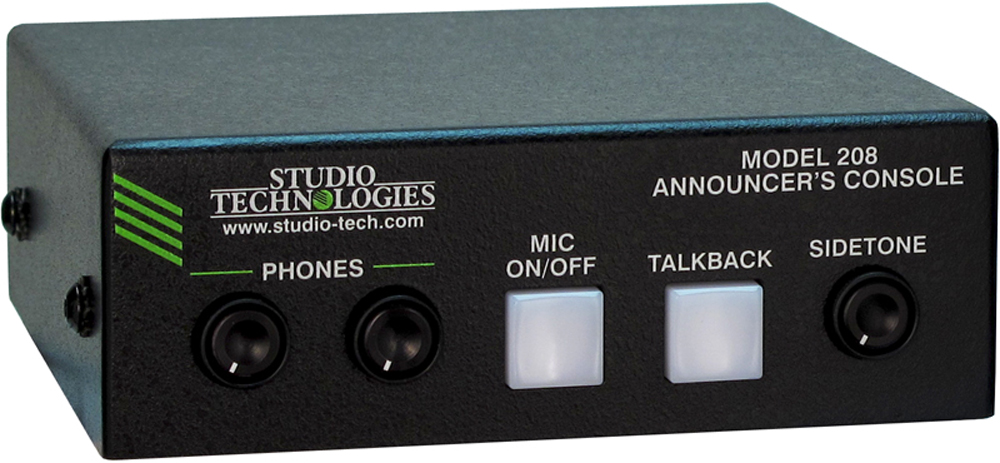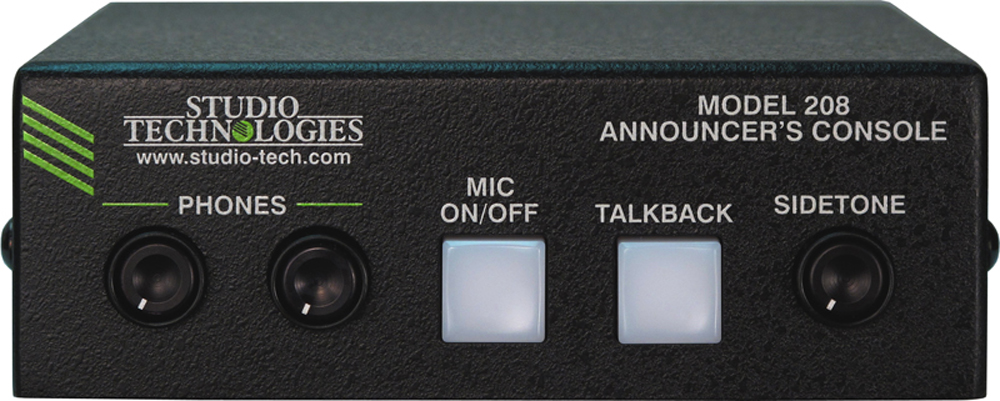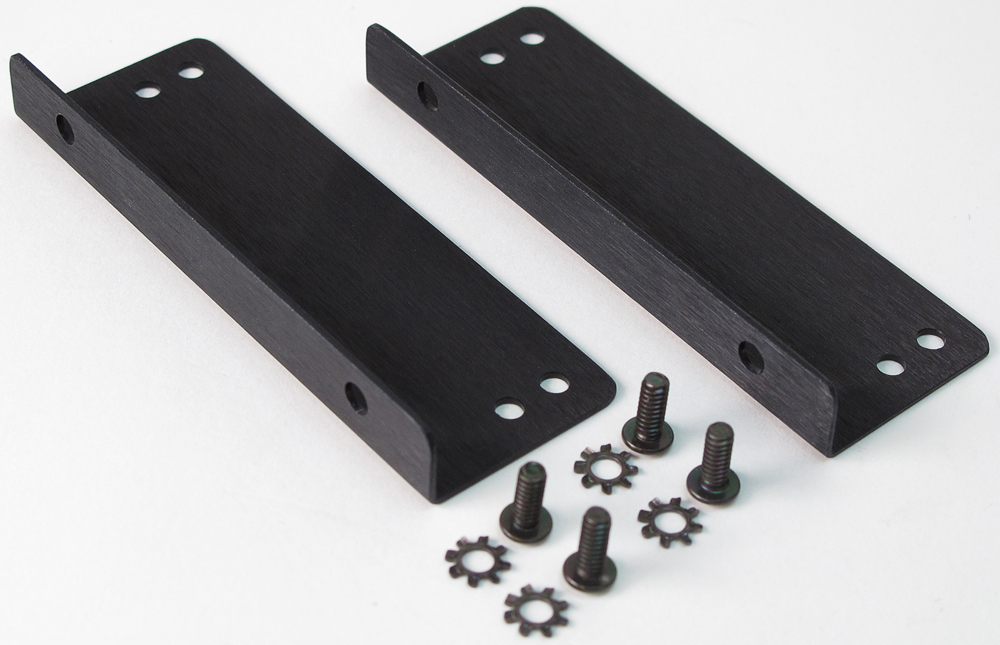The Model 208 Announcer's Console offers a unique combination of analog and digital audio resources for use in broadcast sports, eSports, live event, entertainment, and streaming broadcast applications. The unit is housed in a compact enclosure that's intended for table-top use. Optional mounting brackets provide a simple means of integrating the Model 208 into a variety of broadcast furniture or on-air sets. The Model 208 supports Dante audio-over-Ethernet digital media technology as well as AES67 for integration into contemporary applications. The unit is extremely simple to deploy, is "pro" quality throughout, and provides an intuitive user experience. The Model 208's audio quality is excellent, with low distortion, low noise, and high headroom. Careful circuit design and rugged components ensure long, reliable operation.
The Model 208 integrates directly into both Dante audio-over-Ethernet and standard analog audio environments. With just a Power-over-Ethernet (PoE) connection, a microphone, and a pair of headphones or an earpiece, a complete broadcast on-air position can be created. And by using the Model 208's microphone output a direct connection to an analog microphone-level input on an associated camera, remote I/O interface, or audio console can be supported. Contact inputs allow external signals to work in conjunction with the mic on/off button and talkback button functions.
Key Model 208 features are configured using the STcontroller personal computer software application. An extensive set of parameters allows the unit's operation to be tailored to meet the needs of many applications. STcontroller, compatible with version 7 and later of the Windows® operating system, is a fast and simple means of confirming and revising the unit's operating parameters.
Applications
The Model 208 on its own can provide an "all-Dante" solution for one on-air talent location. A wide range of applications can be supported, including sports and entertainment TV and radio events, streaming broadcasts, corporate and government AV installations, and post-production facilities. Two Dante receiver (audio input) channels supply the user with their talent cue (IFB) signals. Should the cue signal be "mix-minus" an integrated sidetone function can provide the user with a microphone confidence signal. Two Dante audio output channels, one designated as main (for on-air) and the other talkback, are routed via
an associated local-area network (LAN) to inputs on Dante-compatible devices. Two pushbutton switches, microphone on/off and talkback, provide the user with direct control over audio routing. The audio switching is performed in the digital domain and is virtually "click-free."
By providing the main (on-air) audio signal in two forms, Dante digital audio and analog microphone level, the Model 208 makes integration into a wide range of environments easy to accomplish. And with the talkback audio available as a Dante output channel, routing to inputs on a variety of devices, such as matrix intercom systems, audio consoles, and monitor loudspeaker systems, is simple and flexible.
Some applications may benefit from not utilizing the Model 208's Dante main output channel. This typically won't be an issue of inadequate audio quality but rather a need to match work-flow requirements. For example, for lip-sync or transmission purposes it may be optimal to have the on-air audio transported
as an embedded signal along with the associated camera video. Alternately, all on-air audio sources may need to connect to inputs on an audio console or console-related I/O unit. Supporting these scenarios is not a problem as the Model 208 supplies a microphone output connection that's specifically intended for this purpose. Simply connect the unit's microphone output connection to the desired analog input, such as the mic/line input on an ENG-style camera—that's it!
The circuitry associated with the Model 208's analog microphone output is very simple, essentially a passive path that routes a signal connected to the microphone input connector directly to the microphone output connector. A solid-state circuit, in series with the mic in-to-mic out path, allows muting of the signal on the microphone output connector whenever the microphone output is off or the talkback function is active. And it's important to note that using the microphone output connection doesn't impact the normal functioning of the Dante main and talkback output channels. This can be valuable, such as when utilizing the Dante main output channel as a backup, secondary, or redundant on-air audio signal.
Setup and Operation
Set up, configuration, and operation of the Model 208 is simple. An etherCON® RJ45 jack is used to interconnect with a standard twisted-pair Ethernet port associated with a PoE-enabled network switch. This connection provides both power and bidirectional digital audio. A broadcast headset or handheld ("stick") microphone can be directly connected to the unit's 3-pin XLR mic input connector. The input is compatible with a dynamic or condenser microphone. The integrated P48 phantom power source allows operation with a wide range of condenser microphones. A 3-pin XLR mic output connector provides a
"direct mic out" function for integration with mic inputs on related devices. Stereo headphones, the headphone connections from a stereo or monaural headset, or even a monaural earpiece can be connected to the phones output jack. External switches can be connected to the Model 208 to allow remote control of the button functions. The STcontroller software application is used to configure the wide range of Model 208 operating parameters. This allows the unit's performance to be optimized to meet the needs of specific applications.
The user is presented with two pushbutton switches and three "push-in/push-out" rotary level controls. This makes it easy to control the status of the microphone and talkback outputs as well as adjusting the signals that are sent to the headphone channels.
Ethernet Data and PoE
The Model 208 connects to a local area network (LAN) by way of a standard 100 Mb/s twisted-pair Ethernet interface. The physical 100BASE-TX interconnection is made by way of a Neutrik® etherCON RJ45 connector. While compatible with standard RJ45 plugs, etherCON allows a ruggedized and locking interconnection for harsh or high-reliability environments. An LED displays the status of the network connection.
The Model 208's operating power is provided by way of the Ethernet interface using the 802.3af Power-over-Ethernet (PoE) standard. This allows fast and efficient interconnection with the associated data network. To support PoE power management, the Model 208's PoE interface reports to the power sourcing equipment (PSE) that it's a class 1 (very low power) device. If a PoE-enabled Ethernet port can't be provided by the associated Ethernet switch a low-cost PoE midspan power injector can be utilized.
Dante Audio-over-Ethernet
Audio data is sent to and received from the Model 208 using the Dante audio-over-Ethernet media networking technology. As a Dante-compliant device, the Model 208's two output (Dante transmitter) and two input (Dante receiver) audio channels can be assigned to other devices (routed) using the Dante Controller software application. The Dante transmitter and receiver channels are limited to supporting four Dante flows, two in each direction. The digital audio's bit depth is up to 24 with a sampling rate of 44.1, 48, 88.2, or 96 kHz. Two bi-color LEDs provide an indication of the Dante connection status. An additional LED displays the status of the associated Ethernet connection.
The Model 208 is compatible with the AES67 interoperability standard. In this mode the two transmitter (output) channels will function in multicast; unicast is not supported. In addition, the unit is compatible with the Dante Domain Manager™ (DDM) software application.
Audio Quality
The Model 208's audio performance is completely "pro." A low-noise, wide dynamic-range microphone preamplifier and associated voltage-controlled-amplifier (VCA) dynamics controller (compressor) ensures that mic input audio quality is preserved while minimizing the chance of signal overload. The output of the microphone preamp and compressor is routed to an analog-to-digital conversion (ADC) section that supports sampling rates of 44.1, 48, 88.2, and 96 kHz with a bit depth of up to 24. The audio signal, now in the digital domain, routes through the processor and on to the Dante interface section where it is packetized and prepared for transport over Ethernet.
Audio input signals arrive via the Dante receiver channels and pass into the Model 208's processor. The sampling rate will be 44.1, 48, 88.2, or 96 kHz with a bit depth of up to 24. Channel routing, headphone level control, and sidetone creation are performed within the digital domain. This provides flexibility, allows precise control, and keeps the three level potentiometers (two for audio inputs and one for sidetone) from having to directly handle analog audio signals. The two audio channels destined for the phones outputs are sent to a high-performance digital-to-analog converter and then on to robust driver circuitry. High signal levels can be provided to a variety of headsets, headphones, and earpieces.
Configuration Flexibility
The Model 208 can be configured to meet the needs of specific applications and user preferences. All configuration choices are performed using the STcontroller personal computer software application which is compatible with version 7 and later of the Windows operating systems. There are no mechanical switches settings or button-press sequences required to configure how the unit functions. Selectable parameters include microphone preamplifier gain, P48 phantom power on/off, button operation, headphone output mode, sidetone operation, and overall unit operation. The gain of the microphone preamplifier can be selected from among four choices. This allows the Model 208 to match the output sensitivity of a range of handheld and headset-associated microphones. A low-noise source of P48 phantom power can be enabled if required to support a variety of high-performance microphones.
The mic on/off and talkback pushbutton switches, located on the Model 208's front panel, can be individually configured. The mic on/off button can be selected to operate from among four modes while the talkback button can be selected from among three. These choices allow the Model 208's operation to be tailored to meet the specific needs of many applications. As an example, for on-air sports the mic on/off button would typically be configured to provide a push to mute (cough) function. The microphone signal would typically remain active unless the talent needs to momentarily disable it. The talkback button would most likely be set in its push to talk mode as its use would be intermittent.
The headphone output mode can be configured from among four choices. The level/level mode is provided for broadcast applications where two channels of talent cueing ("IFB") need to be independently sent to the left and right headphone output channels. In on-air sports events it's typical for program audio with director interrupt to be sent to the left headphone output while program-only audio is sent to the right headphone output. The level/balance mode is intended for applications where a stereo signal is being routed to the Model 208's Dante inputs. In this mode the user is provided with one potentiometer to control the overall level of both headphone output channels and a second potentiometer to control the left/right level balance.
The dual-channel monaural mode allows the two Dante input audio channels to be summed (mixed together) and sent to both the left and right headphone output channels. Lastly, a unique single-channel monaural mode is provided for on-air talent cue applications where a single-channel earpiece or earbud is being used. The two Dante audio input channels are mixed and sent only to the left channel of the headphone output. No audio signal is present on the headphone output's right channel.
The integrated sidetone function can be configured from among four choices. This allows audio associated with the microphone input and microphone preamplifier to be returned to the headphone output. This is important as different applications may provide a "full mix" or a "mix-minus" talent cue signal. If a full mix cue signal is provided then sidetone audio will not be needed and the function can be disabled. In the case where a mix-minus signal is present, providing the user with sidetone can be an important means of confirming the signal that's coming from the connected microphone.
The headphone gain range configuration helps to provide an optimized audio level to Model 208 users. The appropriate setting will depend on the specific audio sources provided to the unit as well as user preference.
Three system modes select the overall way in which the Model 208 functions. The on-air mode is optimized for applications where users will be on-air talent that must maintain strict separation between on-air and production audio channels. Other applications will be benefit from the two available production modes.
Future Capabilities and Firmware Updating
The Model 208 was designed so that its capabilities and performance can be enhanced in the future. A USB connector, located on the unit's main circuit board (underneath the unit's cover), allows the application firmware (embedded software) to be updated using a USB flash drive.
The Model 208 uses Audinate's Ultimo™ integrated circuit to implement the Dante interface. The firmware in this integrated circuit can be updated via the Ethernet connection, helping to ensure that its capabilities remain up to date.





